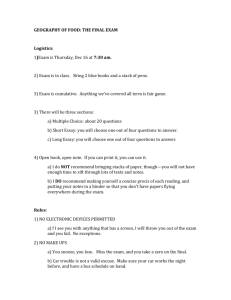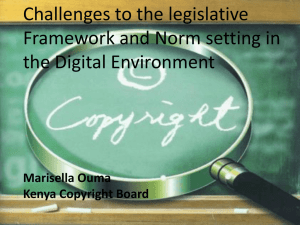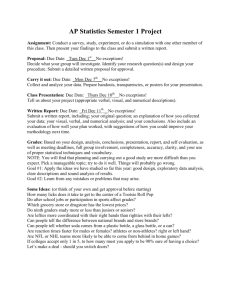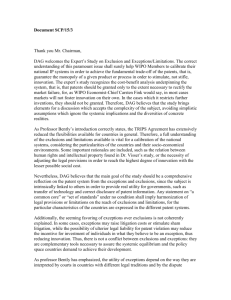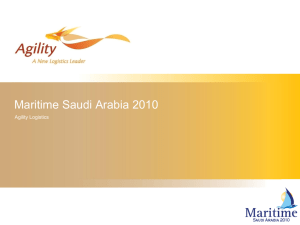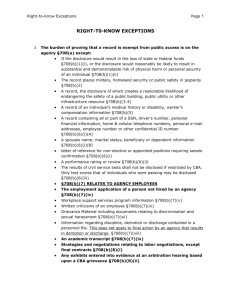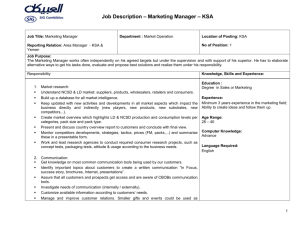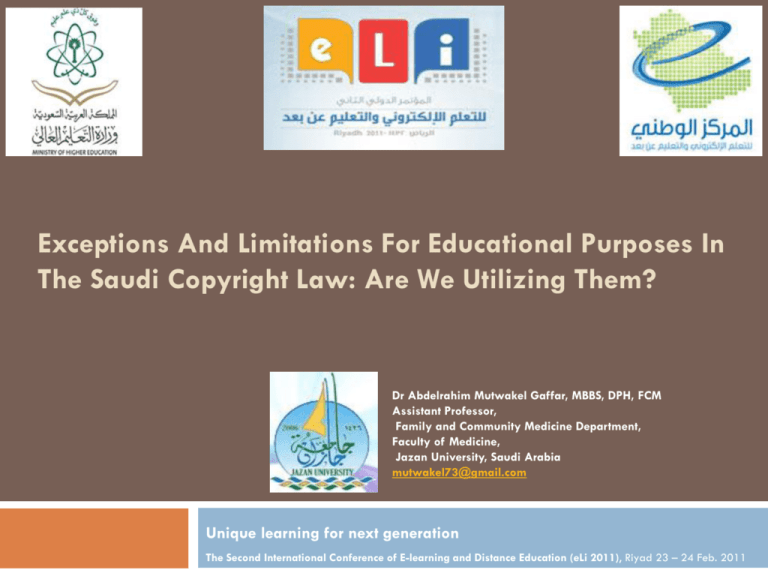
Exceptions And Limitations For Educational Purposes In
The Saudi Copyright Law: Are We Utilizing Them?
Dr Abdelrahim Mutwakel Gaffar, MBBS, DPH, FCM
Assistant Professor,
Family and Community Medicine Department,
Faculty of Medicine,
Jazan University, Saudi Arabia
mutwakel73@gmail.com
Unique learning for next generation
The Second International Conference of E-learning and Distance Education (eLi 2011), Riyad 23 – 24 Feb. 2011
Objectives
The objectives of this paper are to;
1)
Highlight the copyright laws development and history,
2)
Explore the exceptions and limitations in KSA copyright
law for educational purposes, and
3)
Raise the academic community awareness about the
exceptions in copyright law and alternatives.
Outlines
Introduction
International context of Intellectual Property (IP)
protection
Copyright law in KSA
The exceptions for education in KSA law
New challenges
Alternatives
OnlineLegalDetails.com
Outlines
Introduction
International context of IP protection
Copyright law in KSA
The exceptions for education in KSA law
New challenges
Other alternatives
Intellectual Property (IP) protection
Copyright: Authors' rights, Related rights, Moral
rights.
Patent: Utility model
Trademark.
Trade secret.
Intellectual Property (IP) protection objectives
Intellectual Property international treaties main
objectives are to:
reward
creativity;
stimulate innovation;
and contribute to economic development;
While safeguarding the public interest.
Many flexibilities and exceptions were embedded as
integral part of IP international treaties
Background
Intellectual property protection
agreements and laws try to reach a
balance between the rights of
authors and their beneficiaries on one
hand, and the public interest on the
other hand.
(Nabhan, 2009)
Background (cont.)
IP protection laws are not a legal issue now.
It is a human right issue, as these laws have a
profound impact on:
Education
(access to knowledge);
Health (access to medicine);
Research (access to technology); and
development.
Outlines
Introduction
International context of IP protection
Copyright law in KSA
The exceptions for education in KSA law
New challenges
Other alternatives
First copyright law
The Statute of Anne in Britain (1710)
Guaranteed a limited term of copyright protection: 14 years
renewable once if the author was alive.
After the protection term expires, the work falls into the public
domain.
Book publishers feared the consequences of such event, which
would undermine their monopolistic positions and weaken
their profits.
They sought the extension of the protection period.
USA copyright law
1790: the first copyright law In the United States endorsed (14
years).
1831: the American copyright law was amended to increase
the first protection term from 14 to 28 years.
1976: Copyright Law extended all existing Copyrights for an
additional 19 years.
(Tawileh, 2009).
USA copyright law
Then the law granted a period of copyright protection that
extends to the life of the author plus fifty years.
1998: The Sonny Bono Copyright Term Extension Act (also
called the Mickey Mouse act, as Disney was the major player in
lobbying for its passage) extended the term of copyright
protection of all works for 20 years.
This means that the current effective copyright protection term is
about 95 years.
(Tawileh, 2009).
Copyrights
Copyrights Protection period in years 1710 - Protection
1998
period
in years, 1998,
95
Copyrights
Protection period
in years, 1976,
47
Copyrights
Protection period
in years, 1710,
14
Copyrights
Protection period
in years, 1831,
28
International context
1883: Paris Convention for the Protection of Industrial Property.
Is the first major international treaty designed to help the people
of one country obtain protection in other countries for their
intellectual creations in the form of industrial property rights.
1886: The Berne convention which is the first international
recognition of copyright, the convention updated and amended
several times.
International context
1893: The United International Bureaux for the Protection of
Intellectual Property,
which had been established to administer the Berne Convention
for the Protection of Literary and Artistic Works and the Paris
Convention for the Protection of Industrial Property.
Which was the predecessor to WIPO.
World Intellectual Property Organization (WIPO)
WIPO was formally created by the Convention Establishing the
World Intellectual Property Organization, which entered into
force on April 26, 1970.
Under Article 3 of this Convention, WIPO seeks to "promote the
protection of intellectual property throughout the world."
WIPO became a specialized agency of the UN in 1974.
International treaties related to IP
Under the leadership of WIPO many international treaties
related to copyright developed:
1994: Agreement on Trade-Related Aspects of Intellectual
Property Rights (TRIPS Agreement).
1996: WIPO Copyright Treaty (WCT).
1996: WIPO Performances and Phonograms Treaty.
Exceptions in International treaties
All these international treaties and agreement contains
provisions of exceptions for education and research purposes.
Exceptions include fair dealing and fair use, and such use does
not require the permission of the copyright owner.
Outlines
Introduction
International context of IP protection
Copyright law in KSA
The exceptions for education in KSA law
New challenges
Other alternatives
The WTO TRIPS Agreement
Trade-Related Aspects of Intellectual Property Rights
153 Members by membership to the WTO
Article 13: Limitations and Exceptions
Members shall confine limitations or exceptions to exclusive
rights to certain special cases which do not conflict with a
normal exploitation of the work and do not unreasonably
prejudice the legitimate interests of the right holder. [Similar to
the Berne three-step test]
Copyright Law in KSA
Kingdom of Saudi Arabia ratifies Berne convention in 2004 and
WTO in 2005 including TRIPS.
The national Saudi Arabia Copyright Law endorsed by the Royal
Decree No. M/41 on 2 Rajab, 1424 (30/08/2003)
(Nabhan, 2009).
What copyright provides?
Several exclusive rights typically attach to the holder of a
copyright:
to produce copies or reproductions of the work and to sell those
copies
to import or export the work
to create derivative works (works that adapt the original work)
to perform or display the work publicly (performance rights)
to sell or assign these rights to others
to transmit or display by radio or video (broadcasting rights)
Saudi copyrights law analysis
Exceptions to copyright concerning uses of works for teaching illustration purposes.
These exceptions are based directly on Article 10 (2) of the Berne Convention.
Exceptions for purposes of quotations from works. They are also directly based
on a provision of the Berne Convention, Article 10 (1).
Exceptions relating to reprographic reproductions of works for teaching, research
and examination purposes.
Exceptions concerning the public performance of works as part of teaching
activities.
Exceptions in the area of neighboring or related rights.
Outlines
Introduction
International context of IP protection
Copyright law in KSA
The exceptions for education in KSA law
New challenges
Other alternatives
The exceptions for education in KSA law
Exception area
Meaning
Article
Section i: Utilization of works as
illustrations for teaching
making possible the
Articles 15 (3) and 15 (9)
utilization of works as
illustrations for teaching
Section ii: Exceptions for
quotations taken from works
Provides exception for
purposes of quotation
Article 15(2)
Section iii: Reprographic
reproductions of works for testing,
teaching and research
Not mentioned
NA
Section iv: Performance or
communication of works in
educational establishments
allow the performance
or communication of
works in educational
establishments
Articles 15(8)
Section v: Exceptions applicable
to neighbouring rights (or related
rights)
Not mentioned
NA
Section i: Utilization of works as illustrations for teaching
Article 15: The following uses of the copyrighted work, in its original language or in
translation, are lawful without obtaining the permission of the copyright owner. These
forms of use are:
…
(3) Using the work by way of clarification for educational purposes, within the limits
justified by the intended objective, or making a copy or two for public libraries or noncommercial documentation centers on the following conditions:
( ) Shall not be commercial or for profit.
()
Copying shall be restricted to the requirements of activities.
()
Shall not impair the material benefit of the work.
()
The work is out of print or is lost or damaged.
(9) Copying short quotations from published works, drawings, pictures, designs or
maps in school books prepared for educational curricula or in books of history, literature
and art, provided that copying is within the limits of necessity and that the title of the
work and the name of the author are mentioned (Saudi Arabia, 2003)
Section ii: Exceptions for quotations taken from works
Article 15: The following uses of the copyrighted work, in its
original language or in translation, are lawful without obtaining
the permission of the copyright owner. These forms of use are:
…
2) Quoting passages from the work in another work, provided
that such quotation is consistent with the conventional practice
and within the limits justified by the intended objective, and
provided that the source and name of author are mentioned in
the work where the quotation is cited. This shall also apply to
journalistic summaries abstracted from newspapers and
periodicals (Saudi Arabia, 2003)
Section iv: Performance or communication of works in
educational establishments
Article 15: The following uses of the copyrighted work, in its
original language or in translation, are lawful without obtaining
the permission of the copyright owner. These forms of use are:
…
(8) Music playing, acting, performing or showing any work,
after publication, by government troupes or public corporate
entities or school theatre, as long as such playing, performance
or acting does not lead to direct or indirect financial gains.
(Saudi Arabia, 2003).
Section iii and v: Not mentioned
Related rights example: a CD recording of a song is
concurrently protected by four copyright-type rights:
Authors' rights of the composer of the music
Authors' rights of the lyricist
Performers' rights of the singer and musicians
Producers' rights of the person or corporation that made the
recording
Section iii: reprographic reproductions of works for testing,
teaching and research
Section v: exceptions applicable to neighbouring rights
(or related rights)
Section iii and v in other regional laws
Twelve Arab countries make provisions for exception
permitting educational establishments or research centers to
reproduce copies of works, at the request of researchers or
students, for purposes of teaching or research.
Nine Arab countries copyright laws contain an exception for
performances by artists, phonograms or broadcasts by
broadcasting bodies, for educational uses.
Outlines
Introduction
International context of IP protection
Copyright law in KSA
The exceptions for education in KSA law
New challenges
Alternatives
Digital Issues
Time-shifting (E.g., recording a TV show for later
viewing)
Circumventing Technological Protection Measures –
TPMs (E.g., making back-up copies of digital-format
music)
Making archival copies of copyrighted works at
libraries and other public institutions.
Sharing electronic copies
Current issues being discussed at WIPO
Utilization of exceptions and limitations for the benefit
of educational activities, including distance education
and the trans-border aspect thereof, in particular for
developing and least developed countries.
The special needs of visually impaired persons and
other reading-disabled persons, including discussions at
the national and international level on possible ways
and means facilitating and enhancing access to
protected works.
Outlines
Introduction
International context of IP protection
Copyright law in KSA
The exceptions for education in KSA law
New challenges
Alternatives
Implications of copyright protection extensions
a) They contradict the original concept of copyright as a tool to
balance the benefits to the author and society,
b) The limitation of copyright protection terms became
legitimately questionable, as no end point can be envisaged of
possible future extensions, and
c) All these extensions practically mean that the transition of
works into the public domain is continually delayed.
Is there any
other legal
alternatives for
copyright laws?
YES
Alternatives within the © System
Creative Commons
Open access
Free soft ware movement (GNU)
All rights
Reserved
C
Some
rights
reserved
No rights
reserved
CC
PD
Free soft ware movement (GNU)
www.gnu.org
Open access Journals
www.doaj.org
Creative Commons
Share, Remix, Reuse — Legally
Creative Commons provides free tools that let
authors, scientists, artists, and educators easily
mark their creative work with the freedoms
they want it to carry.
You can use CC to change your copyright
terms from ‘All Rights Reserved’ to ‘Some
Rights Reserved.’
License Your Work!!
http://creativecommons.org/licenses/
Licensing Step 1: Choose condition
Licensing Step 2: Receive a license
International Jurisdictions
The CC Affiliate Network consists of 100+ affiliates working in
over 70 jurisdictions to support and promote CC activities
around the world.
The international license suite is appropriate for use in all
countries that are signatories to established international
copyright treaties.
Local community outreach program demonstrated the need
and demand for a jurisdiction-specific license suite.
Jordan
Lebanon
Syria
Egypt
Recommendations
Promotion of the use of International Creative
Commons (CC) license for e-learning material in
JUSSUR system.
Development of a National Creative Commons law
which will provide legal local frame for enhancing
knowledge sharing.
Thanks for your attention
This is licensed under a Creative Commons Attribution-NonCommercial-ShareAlike.

